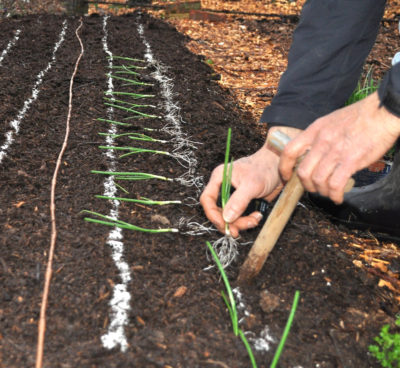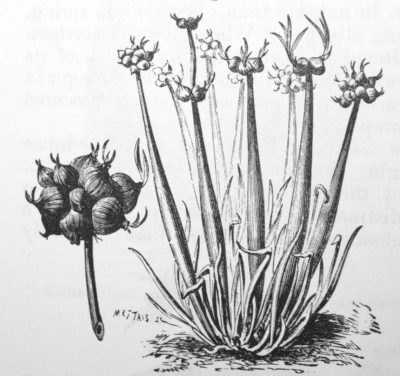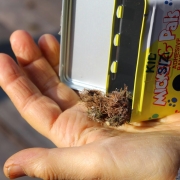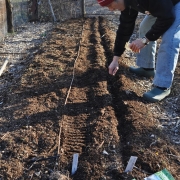NO SIGN OF SPRING HERE YET, BUT . . .
The Onion Cycle Begins Again
Early February, February 6th to be exact, was the official opening of my 2017 gardening season. No fireworks, waving flags, or other fanfare marked this opening. Just the whoosh of my trowel scooping potting soil into a seed flat, and then the hushed rattle of seeds in their paper packets. And the grand opening was not for a flamboyant, who-can-reap-the-earliest-meal of a vegetable like peas or tomatoes.
No, the grand opening for the season is rather sedate: I sowed onion seeds in mini-furrows in a seed flat. Why onions? In addition to the fact that I love the flavor of onions raw and cooked, onions need a long growing season. The summer growing season is cut short because the plants stop growing new leaves to put their energy into swelling up their bulbs when daylengths grow sufficiently long, 14 hours long, to be exact. Around here, that happens sometime in May. The more leaves the plants make before then, the bigger the bulbs. Hence my early planting.
So I poured about a 3-inch depth of potting soil into an 18 by 24 inch plastic tub in which I had drilled drainage holes, and then made seven parallel furrows in the soil into which I dropped onion seeds. This year I’m growing New York Early, Patterson, and Ailsa Craig. (I also sowed leeks in one of the furrows.) After closing up the furrows, I watered, covered the tub with a pane of glass, and put the tub on a heating mat set at 75 to 80° F.
Done. The season has begun.
Other Beginnings
There are so many ways to grow onions. Let me count the ways, some other ways.
1, and easiest, is to just plant onion sets, those mini-onions you can buy to plant as soon as the ground outside warms and dries up a bit. One downside to sets is that the variety selection is very limited. Not only limited, but also restricted to so-called “American-type” varieties, which keep very well but are very pungent and not very sweet. Onion sets that are too large — larger than a dime — tend to go to seed. Plants going to seed look very pretty but don’t make bulbs for eating.
Number 2 method overcomes one of the limitations of method number 1: Purchase onion plants, which are growing plants, with leaves. The sweet “European-types” — Ailsa Craig, Sweet Spanish, and Granex, for example — are available in this form. The plants are grown in fields in the South, and there’s the potential to bring a disease into the garden on these plants. Also, “organic” onion plants might be hard to find.

Setting out onion transplants
Method number 3 is the most involved. (I’ve never tried it.) Grow your own onion sets. The trick is to sow the seeds outdoors densely enough so that they bulb up while still small — dime size. Once bulbs mature, their harvested to store for winter, and then planted in spring just like the sets in Method 1.
Method number 4 is fairly easy, and that is to sow seeds of the Evergreen variety onions right in the ground in spring. This variety never forms bulbs but makes tasty green onions, or scallions. It’s also perennial, so any scallions left in the ground will multiply year after year. The downside here is that you don’t get onions for winter. I grow these every year and do get them for winter use also, in my greenhouse.
Method number 5 is easiest of all. Grow Egyptian, or Walking, onions. This is another perennial onion. It “walks” by forming bulblets on top of some stalks. The weight of the bulblets pulls down the stalk, and when the bulblets touch ground, they root to make new plants. The new plants eventually send up bulblet-topped stalks which likewise bend to the ground, etc., etc., walking the plants around. To me, Egyptian onions are all hotness with little other flavor. I no longer grow them.

Walking onions
I learned of method number 5 from Jay at Four Winds Farm. Simple enough. Just sow the seeds outdoors as soon as the ground is warm enough and dry enough for a nice seedbed. A nice seedbed is key here, because onions compete very poorly with weeds and the goal is to get the seeds to germinate as fast as possible. I tried this last year and the bulbs ended up pretty much the same size as those from the plants I sowed last February and then transplanted into the garden in April. So I get a wide choice of varieties without having to start the seeds in February. Thanks Jay. (I’m growing transplants and direct seeding this year, just to make sure.)
My Pea Planting Will Not Be On St. Pat’s Day!
My early February onion-sowing date isn’t some magical date. My greenhouse is only minimally heated, making for very slow growth early in the season. Growth picks up as sunlight grows more intense and further warms the greenhouse. A week or more difference in sowing date early in the season doesn’t translate into that much difference in growth near harvest time.
The same goes for pea-planting, which is attended by more fanfare than onion planting. Many gardeners rush to get their pea seeds planted by St. Patrick’s day, but planting a week later doesn’t delay that harvest by a week. Perhaps by a couple of days or by a few hours, depending on the season. And anyway, St. Patrick’s day might be the traditional date for planting peas in Ireland, but it would be way too early in Maine and way too late in Georgia. I plant peas here in Zone 5 on April 1st, give or take a few days.
In my book Weedless Gardening, I have a chart that shows what and when to plant, whether as seeds, indoors or out, or as transplants, for all regions. All you have to do is plug in your average date for the last killing frost of spring and the first killing frost of autumn. This date is available from your local Cooperative Extension Office.




I planted onions inside back in December. I just transplanted most of them. The peas are already coming up. OK vs NY I suppose. But also a super warm February here. I started a little earlier than usual.
They should be okay because onions are monocots, with their growing point below ground. So even if leaves freeze a little, the growing point should be okay.
What should be the soil temp if sowing seeds direct? You just said warm. I have raised bed so warm up early. In zone 6, northern KY.
Thanks.
It depends on the kind of seed. Here’s a good reference: http://extension.oregonstate.edu/deschutes/sites/default/files/Horticulture/documents/soiltemps.pdf
Hey Lee,
I would love a post or any advice on starting brassicas by seed for the spring garden. I have tried indoors under grow lights like I would start tomatoes or peppers (which I have plenty of success with). Every year the brassicas grow three or four true leaves then start to wither around the edges then stop growing and die. Its all types to… broccoli, kale, cabbage, collards. I then tried starting them outdoors under glass and in a low tunnel, but it either gets too hot or too cold. Any ideas would be greatly appreciated.
If the edges of the leaves are drying up, it could be a watering problem, either too much or too little. Besides paying closer attention to watering, you might also want to see if changing your potting mix has any effect.
In the setting out onion transplant photo, what are the little white rock looking things all in a line?
That’s just limestone that I sprinkle on the ground as a marker for where to plant.
I have large hands. What should be my first Felco pruner? There isn’t a local store to try them out before buying.
Maybe start with the original bypass #2 or F2 (I think they are the same thing)?
I have some indoor/outdoor citrus pruning to do and don’t love the anvil finish on the ones I got from the big box store.
Love you pruning book, but didn’t see a specific felco model number to start with.
Check out https://www.felcostore.com/comparison
Hi,
How often should leek or onion seedlings be fed? I am trying to grow my own
seedlings this year, instead of buying them at the farmer’s market. I don’t have great luck with sizing on the leeks, although I have gotten much better with the onions. I paid more attention to watering. I finally have a greenhouse and I am hoping that I can get these seedlings to perform better if they don’t stay in the house under lights
until transplant. BTW, I did successfully grow lettuces and spinach right through the winter up here in Maine this year, with a covered hoop bed inside the greenhouse and no heat! I did add an additional Remay blanket loose directly over the plants on very cold nights.
How often to feed them depends on the potting mix. I make my own mix, which includes compost and some soybean meal, both of which supply sufficient N till transplanting time. Keep an eye on your plants, watching leaf color and growth; feed if necessary.